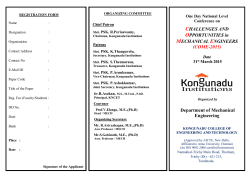
MECH 286 Robotics & Automation Midterm Sample Solution
MECH 286 Robotics & Automation Midterm Sample Solution PART I Flowchart -1- MECH 286 Midterm Solution PART II Question 1 Overdamped 1. Critically damped Underdamped Quarter Amplitude Decay The controller is hereby tuned to make each successive peak ¼ of the preceding one. 2. Minimum integral of absolute error The control system is manipulated to minimize the total absolute area under the response curve (The integral of absolute error is the total area on the curve). 3. Critical damping This approach is used where overshoot is undesirable. The system is adjusted to produce a response with no overshoot and no oscillations. Electrical instruments and some processes are critically damped. -2- MECH 286 Midterm Solution Follow-up system Sequential system Regulator system Regulator system Sequential system Follow-up system PART II Question 2 -3- MECH 286 Midterm Solution Gain = 1.6 mA/(L/min) Cm = 1.6C + 4 mA Cm = 13.6 mA C = 0 L/min Resolution = VLSB = 5V/210 = 0.00488V Quantization error = ± VLSB/2 = ± FSV/2n+1 = ± 10V/212+1 = ±0.00122V PART II Question 3 h1 = previous h2 = 0.195579 m E = hsp – h1 = 0.25 – 0.195579 = 0.054421 m SumE = 0.22965 + 0.054421 = 0.284071 m Qin = PE + I*dt*SumE = (8*0.0554421) + (3*0.1*0.284071) = 0.520589 m3/s dh = (Qin – Qout) * dt/A = (0.520589 – 0.5) * (0.1/1) = 0.002059 m h2 = h1 + dh = 0.195579 + 0.002059 = 0.197638 m h2 keeps increasing past the 0.8s mark (in contrast with the purely mechanical system). This can be explained by the fact that the integral component of the controller acts on the left over error (residual error) and tries to minimize it. As time passes by, the residual error will keep decreasing until the setpoint is achieved. Increasing the I gain will decrease the time that it takes for the system to achieve the setpoint. Increasing it further may cause the system to become unstable. -4-
© Copyright 2025





















